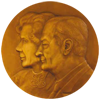
Ann-Charlotte Söderpalm, orthopedic surgeon at Sahlgrenska University Hospital. She wants to find out how children with fractures recovers after a bone fracture, and if there is an increased risk that they break up again. NOTE – This article is machine translated from Swedish.
Orthopedist and researcher Ann-Charlotte Söderpalm would like to find out how children with fractures recovers after a bone fracture, and if there is an increased risk that they break up again. Boys with severe muscle disease may help to strengthen their bones in a parallel research project.
Ann-Charlotte Söderpalm presses into their research hours in an already-välmatat job scheduler as a doctor at three workplaces. Right now, her research focused on two large studies. The first concerns the healthy child’s bone quality. In the second she meets disabled children with two forms of muscular dystrophy, Duchenne and Becker’s disease, based on her doctoral dissertation from 2009. The more she immerses himself in the skeletal feature the greater her fascination.
— It’s amazing how a variety of factors and various cells and molecules interact. There is a link between osteoporosis and fractures in older people and of severely ill children, but I think that there is such even in healthy children with more fragile bones than normal.
The equipment she uses are gathered in what is known as Dexa-room on the growth unit. A mint green dammsugarliknande apparatus, DXL, has been her retainers during the many years of measurements. It takes an image of the foot’s bones and bone density while the measure hälens thickness.
— It has enabled us to take with us out to the child healthcare centers and schools, but now it is final and we have bought a more modern variant for the grant of half a million from Lundberg’s Research Foundation.
With the new and much more efficient equipment, Ann-Charlotte Söderpalm expand its research on healthy children’s bone density. Through a planned collaboration with the children’s emergency room she gets in contact with children who had broken his leg.
— We’re going to compare a large number of children who get a fracture with children that are not broken and then check how the skeleton is recovering. Then we can see whether there is correlation between bone quality and how fast the child regain normal mobility and becomes as strong as before the injury.
In two stationary devices, other body parts measured. On one side lies a cuddly polar bear, it has more toys and a soothing light and ljudspel similar to the feeling of walking in a sunlit forest in spring. All to create a peaceful atmosphere for the children examined. Some are very sick.
Duchenne and Becker’s is x-kromosombundna disease which only affects boys and affects the protein dystrophin. Sjukdomsförloppen is serious, and the boys can’t go, the muscles gradually destroyed while growing up. Boys with Duchenne often need a wheelchair at the age of. Becker’s disease has a slightly milder process.
— Because the boys find it difficult to move the affected by osteoporosis and the risk that the shedding and breaking increases. If they break the bone, they might be forced to have a wheelchair earlier.
The boys must have wheelchair permanently often develop scoliosis, it becomes harder for them to sit and breathe.
— As we learn more about the skelettfysiologin of the boys can health care in the long run help this group to build a better bone tissue.
Even healthy children’s skelettillväxt impaired by too much sitting still. Other factors that affect is muscle mass, diet, vitamins and hormones. But there are additional factors that are only partly known. Few studies have been done on children’s osteoporosis and it has Ann-Charlott seen as a challenge. One of her research questions are how children and young people can build up a stronger bone tissue.
Ann-Charlotte has worked as an orthopedic surgeon since 1989 and came to the children’s team at East just before the turn of the Millennium. In the evenings at home in Bollebygd leads she workouts in aerobics and yoga.
— It has become my mission to convey how important it is that we move on us. In my job is the ultimate goal of getting the whole child population healthier – and in my spare time I spread the message to adults.
Text and photo: Monica Havström
